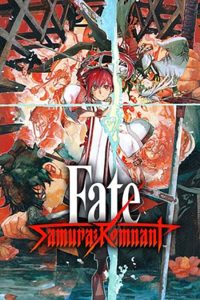Fate/Samurai Remnant
(available for PlayStation 5, Nintendo Switch, and PC. PS5 version used for the review)
The Fate series is one of the most fascinatingly confusing ones out there. It started off with Fate/Stay Night, an eroge visual novel created by TYPE-MOON works, which was later adapted into an anime (following the Fate storyline) by Studio Deen in 2006. As time went on it got a number of sequels, prequels and spin-offs – being told through novels, anime, video games and even a couple CD dramas – and now it’s a highly beloved series with one of the most confusing timelines in media history (seriously, you know things are getting complicated when the bloody doujin manga are considered canon). The latest edition to this pantheon of a series is Fate/Samurai Remnant, which was created by Omega Force and released on the 29th of September 2023 for PlayStation 4 & 5, Nintendo Switch and Steam.
Story
The game takes place in the Keian Era during the Edo Period. You take on the role of Miyamoto Iori, the adopted son and apprentice of Miyamoto Musashi and swordsman for hire. He one day finds himself with a mysterious bruise on his left hand, and despite just being in battle, he doesn’t recall getting hit on the hand. That night, he’s attacked by a heavily armoured samurai and a band of shinobi led by Yui Shousetsu, the Master of the Rider class. Just as Iori’s about to be struck down, his bruise takes the form of a Master’s brand, and summons his own servant, one of the Saber class. Now he finds himself roped into a secret war called The Waxing Moon Ritual, a variant of the Holy Grail War, which has seven masters, each with a servant that was summoned from the past, that must battle against one another to obtain the Waxing Moon and obtain any wish that they desire. Not only that, but this war has summoned eight Servants without Masters, leaving them to become rogues. Now Iori must fight against threats high above his calibre and make unlikely alliances, in order to not necessarily win this war, but merely to survive it.
I’m quite surprised by how much I liked this story, it might be because my only experience with a Fate video game plot is Fate/EXTRA Last Encore which was, to put it bluntly, terrible, but I found myself actually liking this story. The characters are very likeable and easily detestable, you’re never quite sure where it’s going to be going next, and it perfectly mimics the same kind of story found in one of the series’ anime. While it would be better if you were already somewhat versed into the Fate series as there are some basics that are skipped over in this game and there are some returning servants from other stories in the franchise, I still think you can play this game without any knowledge of the series, as it gives you enough information and you don’t need to have watched or played anything previously to understand the story.
Presentation
Graphically, the game looks pretty good. Everything is in that shell-shaded style you’d expect in anime games, and it all looks incredibly smooth. I especially love the character design in this game, they are all insanely creative and are very detailed, each matching the era and place of origins that they come from and are just very pleasing to the eye.
One thing that a lot of people may not like is the lack of an English dub, unfortunately the only option you have for language is its original Japanese. Personally, I really don’t mind this, in all honesty I likely would have played the game in Japanese anyway, but I can understand why it would be a problem with a lot of other players, especially since this game is part visual novel, so there is a lot of dialogs to read.
The soundtrack is pretty good as well, a lot of the songs go for a very Japanese sound, so most contain a lot of traditional wind instruments, making the music match the games theme really well. There aren’t a lot of songs compared to the amount found in other OST’s but what’s there works and is overall very enjoyable.
World Design
The game takes place in Edo, which is split into multiple different locations, it’s basically like Kanai Ward from Master Detective Archives: Raincode. Some areas are small hubs where you can stock up on materials or healing items, while others you’ll mostly likely only visit during a story mission or a side mission. The size of each location varies a fair bit, Asakusa, your main hub level, for example, is pretty large in size, while Futago only really consists of a couple of small but open sections and paths leading to them. I find each area to be just the right size considering what role each one takes in the game, and they are all very easily navigable. You’ll gain access to more of Edo as you play the game, and you can easily fast travel from district to district directly from the map when unlocked.
Combat and Enemy Design
The gameplay is heavily based on Dynasty Warriors, with you fighting off large groups of opponents that are easily slain, pulling off strings of combos mostly designed to fight off large waves. I say, based on rather than just saying it’s a Dynasty Warriors clone because it’s really just the combat that mimics that game; certain gameplay elements such as the capturing of keeps is absent. It’s a lot like Persona 5 Strikers in that sense, as it just takes the combat from those games and does its own thing with the rest.
Unlike a lot of other games of this nature, while there are multiple characters for you to play, you’re not really able to select them whenever you want. You’ll be spending most of your playthrough fighting as Miyamoto Iori while on occasion swapping to Saber. You do play as other Servants, both ones with and without Masters, but when you do- will mostly be decided by the story instead of whenever you want. Well, ok, technically you can swap characters but not in the traditional sense. As you play through the game, you’ll encounter each of the Rogue Servants that were summoned into the Waxing Moon Ritual, and after a brief encounter with them they will agree to fight alongside you. To fight as these Servants, you’ll have to build up a Substitution Gauge as you fight using Iori, once built up you can swap to that Servant but only temporarily, after a short while you’ll be forced back to Iori and will have to build said Gauge back up again. Saber will be with you most of the way through the journey, meanwhile you can only equip one Rogue Servant at a time. I don’t mind this, this is meant to be Iori’s journey so it makes sense that you would fight as him most of the time, plus the Servants are especially powerful against normal enemies, so it makes sense that you wouldn’t be able to fight as them all the time.
To make up for this, Iori has a number of Battle Stances to use. There are five stances in total, and each one not only dictates your playstyle but also the types of combos you can perform. For example, Water Stance is a dual sword style that is fast paced and best used against groups of enemies, while Wind Stance uses a combination of blade and magic and is best used against some of the stronger enemies. There are even some that have extra benefits depending on your status, like Fire Stance being more powerful the less health you have (yes, being too confident with that stance is what lead to most of my deaths). It’s genuinely surprising just how different each stance is, giving you multiple solutions for many different situations, they also benefit from the fact that you’re playing as Iori for most of the game, making playing as him constantly a lot less boring. If you stay in one Stance for long enough, you’ll gain an effect called Afterglow. When in the Afterglow state, if you swap to a different Stance, you gain a temporary buff depending on what you swapped from, for example swapping from Earth Stance stops enemies from staggering you and temporarily decreases damage, meanwhile Water Stance increases your attack speed briefly. I really like this as it encourages players to try out different Stances and will benefit you for doing so.
On top of your regular attacks, you also have access to two extra abilities, Magecraft and Affinity Techniques. Magecraft is a form of magic that is frequently used in the Fate universe, magic that Iori is also able to wield. Your Magecraft spells have a variety of effects, like temporarily increasing your defence or gradually restoring your health for a period of time, though most of them will be some form of fire attack. Casting a Magecraft spell requires you to use crystals, the more powerful and useful the spell is the more crystals it will require. You won’t just regain these as time goes on, but you can gather more by enemies dropping them upon defeat, by using material to create more or by simply buying them. Affinity Techniques work a bit differently; for starters these are your Servant’s abilities, not Iori’s. To use these abilities, you will need to fill up the Affinity Gauge, to do so you simply have to hit enemies. After stronger enemies attack, they will sometimes stall briefly and will begin to glow, if you attack them during that time your Affinity Gauge will increase quicker. While most of the Servants will have their own set of Techniques, Saber’s can be swapped out and you will unlock more as you upgrade her. Some of these attacks can be used by Saber herself, while others will require Iori’s assistance, so you can’t use them while he’s not present. Sometimes in battle, Saber will call you out and if you reach her in time, you will be able to perform an Affinity Technique with her for free, however if she gets hit, or you don’t make it to her before the time limit’s up, then the prompt will be cancelled, and you’ll have to wait until she next calls you. I like both of these abilities, they work surprisingly very differently from one another and really help in battle, especially against stronger enemies.
Speaking of enemies, there’s a decent amount of variety in them. Human enemies are much more limited in diversity than the monsters, as I found that most of them fight very similarly, with the only difference being what weapons they’re carrying. Monsters on the other hand are quite varied, all of which are very creative in design and mechanics. Humans are very easily killed so you’ll be encountering them in very large groups, meanwhile monsters do have more health so while you do still fight them in large groups, you’ll encounter less of them at a time. As mentioned, multiple times, you’ll be fighting a lot of bigger enemies that almost act as mini bosses. These will have a lot more attacks than the smaller guys and will even have some attacks that will make them glow red that can’t be interrupted, those ones are especially painful if you get hit. I’ve got to be honest, fighting these guys is kind of a pain as Iori. The main reason is because of, what I call, their Shield. Like stronger enemies in other Musou games, these ones will have a stagger metre, which when depleted will stagger them and deal a lot more damage, though there’s one thing that this game does that makes these guys a chore, the Servants can attack these beasts whenever they want, Iori can’t. If you try to attack these opponents while the Shield is still active, then the attack will bounce right off. Literally the only time you can attack these monsters as Iori is either during a brief period in between enemy attacks, or when the Shield is down. I hate this and I wouldn’t be surprised if this killed a lot of enjoyment for other players, the Shields already take forever to destroy, and this just makes it take so much longer. I understand there needs to be some benefit to playing as the Servants over Iori, but this is not a good way to do it.
Travelling Across the Leyline
In my opinion, the most interesting part of this game is the Leyline and Spirit Conflicts. At multiple points throughout the story, you will be required to travel across Edo via the Leyline, a series of paths all connected to things called Spirit Fonts. During it you and enemies will take turns moving across the Leyline and capturing Spirit Fonts. If you and an enemy encounter each other on the same Spirit Font, you will be forced into a fight against them. During these fights you may be given a time limit, complete the fight within the time given and you will get a bonus to the rewards at the end. If you manage to capture a Spirit Font which happens to be the home turf for a Servant, you can recruit said Servant and have them capture Spirit Fonts and take part in fights as well.
You also gain access to abilities called Earth Arts, these will help you while traversing the Leyline and aid off enemies, giving you benefits like letting you make two moves in a single turn, stopping your opponents from moving for a single turn or teleporting you to a Spirit Font that you previously captured. You have a limited number of turns while in the Leyline which you can increase by defeating enemies, if you run out of turns then you will have to start back at your last checkpoint. If you cross a path that has been highlighted by an enemy and cut them off from other paths highlighted by them, then they will be automatically defeated, be careful however, as if they cut you off from your start point or capture your start point, it’s an automatic game over. I really like this mode; it acts as a bit of a break from the constant action and it’s generally a lot of fun. Kind of makes me want a game based entirely around this.
Side Content
While there’s not a large variety of side content, there is still a decent amount of it. The main side quests you’ll be doing are the Discretions. Discretions are tasks and missions given to you by nameless NPC’s and later on, some of the more prominent characters you encounter throughout the story. Some of these will involve Iori and Saber collecting a series of items or battling groups of opponents, and sometimes you will be going into the past as another Servant, showing you a significant part of their own story. All of these act like their own mini stories, helping you to get to know the characters a bit more and increasing their bond with Iori and Saber. You do have a time limit to complete these however, as if you go too far into the story without completing these quests, you will lose access to them. I quite like these actually; these quests never go on for too long and it’s cool to see and play more of these characters.
Of course, Iori is a struggling ronin for hire, so understandably there will be people around asking for his services and giving you tasks to complete throughout the story. These are basically in-game achievements, things like upgrading a character to a certain point, or defeating a certain number of enemies using a particular stance or character. Completing these will reward you with some materials and money.
The last one is actually pretty enjoyable. At random times as you’re wandering Edo, Saber will dart forward towards something shiny that’s caught her attention. If you follow and talk to her, you’ll get a small cutscene of Saber asking about the thing and Iori giving a small bit of information. It’s mostly just there as a cute little thing, and I quite like it.
Flaws
Outside of what I’ve already mentioned, there are a couple more flaws that I feel I need to mention. For starters, the game is a bit too easy, granted I am pretty good at these kinds of games, but even then, I still found myself dying a fair amount in those, meanwhile I rarely ever found myself struggling with this one, mostly due to the overabundance of healing items I had.
Second, there are a lot of cutscenes, and they do last for a very long time, it’s not awful as the story is interesting, and there is still enough gameplay there to make sure you don’t get too bored, but it still does get a little annoying after a while, especially with the Discretions (I admit I started zoning out during those scenes around the end).
Finally, just like all the other games in this genre, fighting does get a little tiresome after a while, granted it doesn’t happen quite as quickly, with the amount of cutscenes and the enemies not being entirely made of glass, but it does get monotonous after a while, add in having to fight the stronger enemies as Iori and frustration is imminent.
Conclusion
This is my first introduction to anything Fate related outside of the anime, and I think I’ve picked a pretty damn good one to start with. I thought this game was quite a lot of fun, the combat was solid, the story was really good, and it got me in the mood to see what else the series has to offer. If you’re a fan of the Fate series like myself, then I very highly recommend this to you, and if you’ve never experienced the series before, while I would recommend Fate Zero or Unlimited Blade Works as your starting point, I still think that this is a pretty good introduction.
8.4/10
Anime Amigo and Nerd Consultant
Share This Post:








Leave a Reply